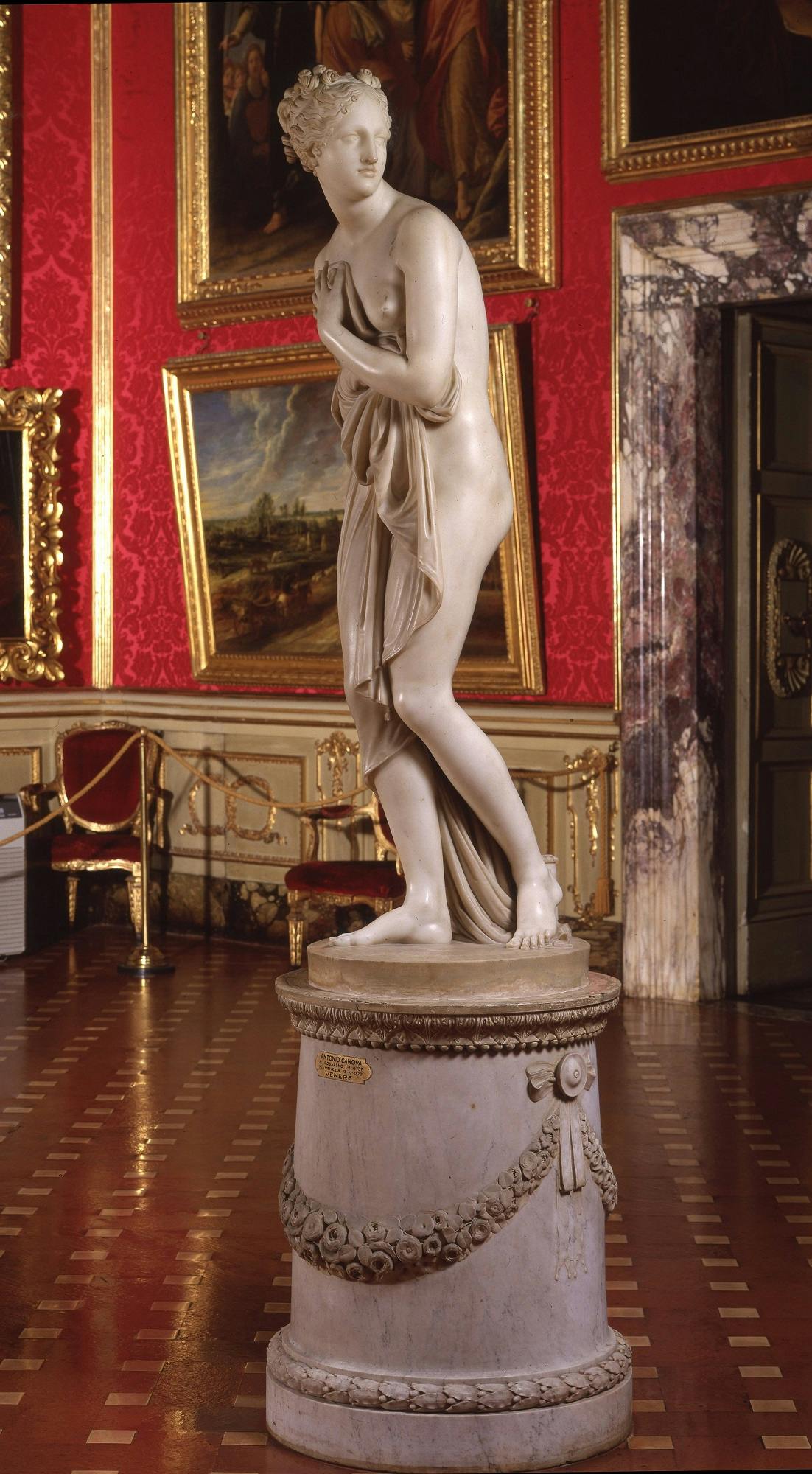Venus Italica
Antonio Canova (Italy, Possagno, 1 November 1757 - Venice, 13 October 1822)
In 1802, passing through Florence and at the height of his notoriety, Antonio Canova was commissioned by the King of Etruria, Ludovico di Borbone, to make a copy of the Venus de' Medici, the 1st century BC marble sculpture that had already been exhibited in the centre of the Uffizi’s Tribune, but had been requisitioned by the French authorities on 11 September of the same year for the Louvre. At first reluctant to the idea of a replica, the Venetian sculptor eventually accepted, enticed both by the proposal to replace such a masterpiece and by the strong patriotic connotation that the undertaking had immediately assumed. However, in the meantime Canova had the idea of challenging the ancient statue with a standing Venus, this time of his own invention. This prestigious commission was confirmed to him in 1805 by the Queen Regent of Etruria, Marie Louise of Bourbon, and the idea of a reproduction of the antique statue was eventually shelved. In 1809 the new sovereign Elisa Baciocchi, who had just been installed as Grand Duchess of Tuscany by her brother Napoleon, succeeded in convincing the emperor to pay Canova the agreed 25,000 francs and on 29 April 1812 the Venus Italica reached the Tribune of the Imperial Gallery in Florence but, instead of being placed on the pedestal of the Medici statue brought to France, it was placed on a new revolving base to highlight the novelty of the creation. In fact, the Canova divinity deviated from the illustrious model, being depicted at the moment when she demurely dries herself after coming out of the bath, with the vase of perfumed ointments at her feet. The new sculpture, whose modernity was immediately highlighted in comparison to the ancient prototype, was an enormous success, which made it the subject of extensive critical literature and the protagonist of numerous sonnets, including one by Giovanni Rosini, who baptised it with the title “Italica”. Ugo Foscolo, contrasting her with the Medici Venus, described her as “a beautiful woman, capable of making people fall in love, while the ancient one is an impassive, albeit beautiful, goddess”. In Canova’s work, in fact, the natural grace is accentuated in comparison to the conventionality of the ideal beauty expressed in the Hellenistic exemplar, thanks to the more dynamic pose and slightly larger dimensions, which make her as tall as a real woman.
After the fall of Napoleon, in 1815 Canova travelled to Paris as an emissary of the Papal States to negotiate the return of the works stolen by Bonaparte and the antique Venus resumed its place in the Tribune, while the Italica, by now ousted, was transferred to the Pitti Palace.
F. Mazzocca, in Antonio Canova, a cura di G. Romanelli, G. Pavanello, Venezia, Marsilio 1992, pp. 282-289, n. 132; H. Honour, Canova e la storia di due Veneri, in G. Capecchi, D. Heikamp, A. Fara, V. Saladino, Palazzo Pitti. La reggia rivelata, Catalogo della mostra (Firenze, Palazzo Pitti, 7 dicembre 2003-31 maggio 2004), Firenze 2003, p. 192; F.Mazzocca in A. Coliva, F. Mazzocca Venere Italica, in Canova e la Venere Vincitrice, Catalogo della mostra (Roma, 18 ottobre 2007-3 febbraio 2008), Milano, 2007, pp. 204-205; F. Mazzocca, in Canova. L'ideale classico tra scultura e pittura, a cura di S. Androsov, F. Mazzocca, A. Paolucci, Milano, Silvana Editoriale 2009, pp. 329-330, nn. VIII,17; M. Ceriana, Pensieri sulla Venere Italica di Canova a Firenze, in Venere nelle terre di Antonio Canova, a cura di M. Guderzo, Terraferma, Crocetta del Montello (TV) 2015, pp. 61-69
Medici Venus
Hellenistic art
